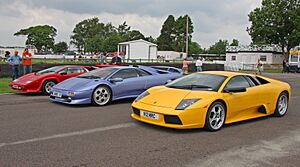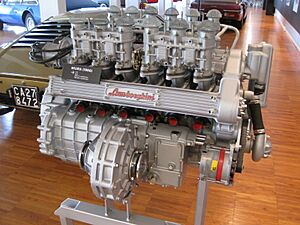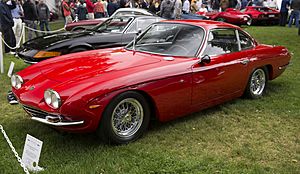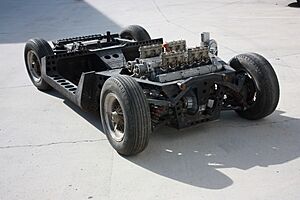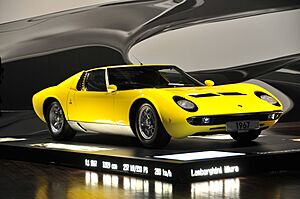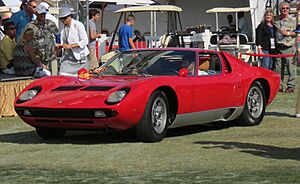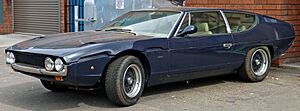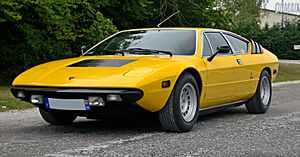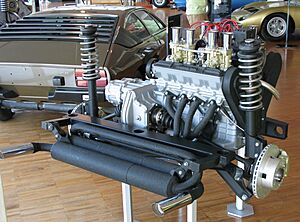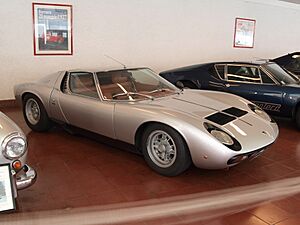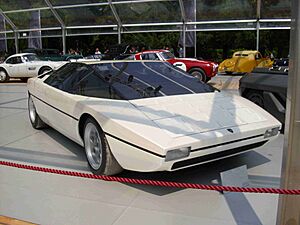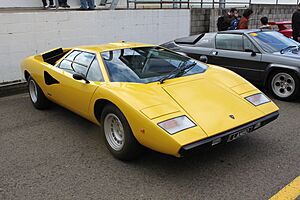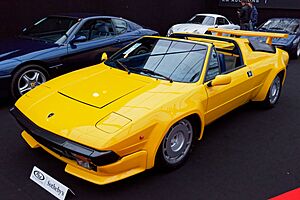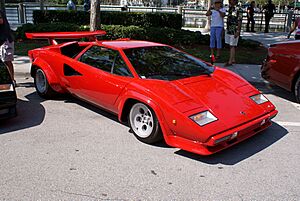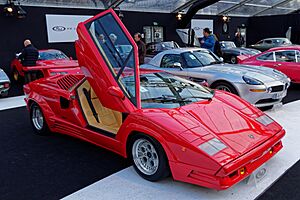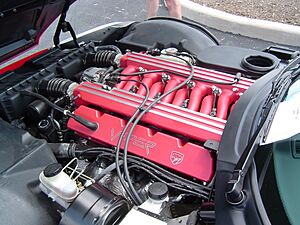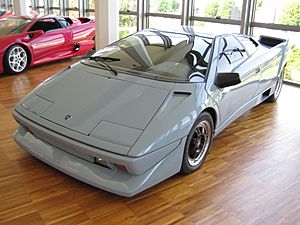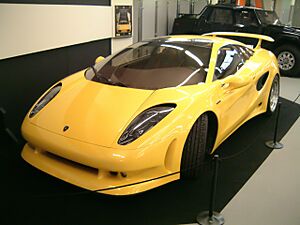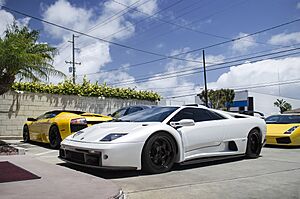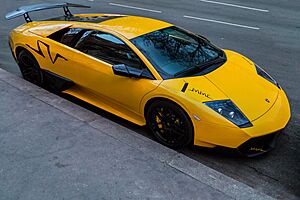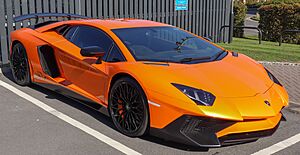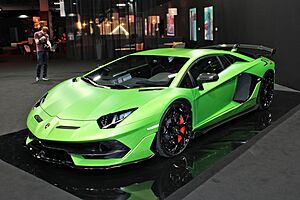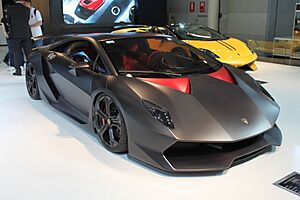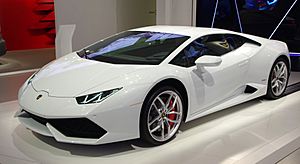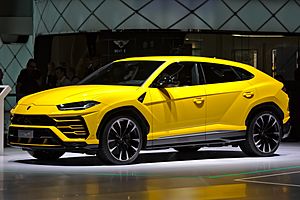History of Lamborghini facts for kids
Automobili Lamborghini S.p.A. is a famous Italian company that makes amazing luxury cars. Their main factory and offices are in Sant'Agata Bolognese, Italy. Ferruccio Lamborghini started the company in 1963. He wanted to build fancy, powerful cars that could compete with brands like Ferrari. Lamborghini's first cars came out in the mid-1960s. They were known for being comfortable, powerful, and well-made. In 1966, the Miura sports car became very famous. It set a new standard for high-performance cars with its engine placed in the middle-rear.
Lamborghini grew quickly at first. But sales dropped a lot in the 1970s because of money problems and the oil crisis. Ferruccio Lamborghini sold his part of the company and retired in 1974. The company faced tough times and went bankrupt in 1978. Later, in 1980, two brothers, Jean-Claude and Patrick Mimran, bought the company. Patrick Mimran invested a lot of money and helped save Lamborghini. Under his leadership, new cars like the Jalpa sports car and the LM002 off-road vehicle were added.
In 1987, Patrick Mimran sold Lamborghini to the Chrysler Corporation. Chrysler introduced the Diablo to replace the Countach. Then, in 1994, Chrysler sold Lamborghini to groups from Malaysia and Indonesia. Finally, in 1998, these groups sold Lamborghini to the Volkswagen Group. Volkswagen placed Lamborghini under the control of its Audi division. This brought new products and helped Lamborghini grow even more.
Early Years (1963–1972)
Building the First Cars
Before starting his car company, Ferruccio Lamborghini hired an engineering firm called Società Autostar. He wanted them to design a special V12 engine for his new cars. Lamborghini wanted an engine for regular roads, not just racing. Giotto Bizzarrini, a famous engineer, designed the engine. It was a 3.5-liter V12. This engine, known as the Lamborghini V12, was used in Lamborghini cars for almost 50 years!
The first Lamborghini car design was created by Giampaolo Dallara and his team. The car's body was styled by Franco Scaglione.
Lamborghini built the 350GTV in just four months for a car show in 1963. There was a problem: the engine wasn't ready in time. So, Ferruccio Lamborghini supposedly filled the engine space with bricks to make the car sit right! The car was shown without a working engine, but people still liked its look.
Automobili Ferruccio Lamborghini S.p.A. officially started on October 30, 1963. Ferruccio Lamborghini built his factory in Sant'Agata Bolognese, Italy. This area was perfect because it was near other car makers and had skilled workers.
Even though the 350GTV got good reviews, Ferruccio decided to change it for production. The new car, called the 350GT, was redesigned by Carrozzeria Touring. The V12 engine was adjusted for regular use. The 350GT was shown in 1964 and also received good reviews. Lamborghini sold each car at a loss to keep prices competitive with Ferrari. About 120 of these cars were sold over two years.
New Models: 400GT and Miura
In 1965, engineers improved the V12 engine, making it 3.9 liters and more powerful. This engine first went into the 400GT, which was like the 350GT but with a bigger engine. In 1966, Lamborghini introduced the 400GT (2+2). This car was a bit longer and had seats for four people. Sales of the 400GT 2+2 helped Lamborghini hire more workers.
Around this time, Lamborghini's engineers secretly worked on a new car. They wanted to build a car that felt like a race car but could be driven on the road. Ferruccio Lamborghini eventually agreed, thinking it could be a good marketing tool.
The car's special chassis, with its engine placed sideways in the middle, was shown in 1965. The body, designed by Marcello Gandini, was finished just before the 1966 Geneva Motor Show. Like before, the engine wasn't fully ready, so the engine bay was kept closed. People loved the car, which was named the Miura. The Miura's design became the standard for high-performance sports cars, even today.
By the end of 1966, Lamborghini was doing very well. The Miura helped establish the company as a leader in sports cars.
Changes and Challenges (1967–1969)
Lamborghini wanted to replace the 400GT. Several designs were tried, but none were approved. Eventually, a new four-seater car called the Islero 400GT was developed. It wasn't as popular as hoped, with only 125 cars made.
New versions of the Miura came out in 1968. The Miura P400 S (Miura S) had a stronger body and more power. A convertible version, the Miura Roadster, was also shown, but it never went into production. 1968 was a good year for Lamborghini, with 353 cars delivered.
In 1968, Giampaolo Dallara, an engineer, left Lamborghini because Ferruccio didn't want to get into racing. Paolo Stanzani took over as technical director. Ferruccio Lamborghini always wanted to build perfect, reliable road cars, not race cars.
In 1969, Lamborghini introduced the Espada, a new four-seater car. It was a big success, with over 1,200 cars sold in ten years. This was Lamborghini's first truly popular model.
Around this time, Lamborghini faced some challenges with its factory workers. But Ferruccio Lamborghini worked closely with his staff, helping them stay focused on building great cars. The company's cars, including the Islero, Espada, and Miura S, all received upgrades that year. The Islero was planned to be replaced by a sportier version of the Espada, called the Jarama 400GT.
New Designs and Challenges (1970–1972)
By 1970, Paolo Stanzani was working on a completely new car, the Urraco. This smaller, V8-powered car was designed to be more practical, even for families. It was the first Lamborghini with a V8 engine.
In 1970, Lamborghini also started designing a replacement for the Miura. This new car, called the LP 500 prototype, had a new, longer design. Its body was styled by Marcello Gandini. It was shown in 1971 alongside the final Miura version, the P400 SuperVeloce.
Around 1971, Ferruccio Lamborghini's businesses started having financial problems. His tractor company faced issues with cancelled orders. Because workers were unionized, they couldn't be laid off. In 1972, Ferruccio sold his tractor company.
The entire Lamborghini group was now in financial trouble. Ferruccio Lamborghini began looking for buyers for his car company. He sold 51% of Automobili Lamborghini to Georges-Henri Rossetti, a Swiss businessman. This meant Ferruccio no longer controlled the company he founded.
Changing Hands (1973–1997)
New Owners and Tough Times (1973–1986)
The 1973 oil crisis made it hard to sell powerful, fuel-hungry cars. People wanted smaller, more practical vehicles. Sales of Lamborghini's exotic sports cars suffered greatly. In 1974, Ferruccio Lamborghini sold his remaining share of the company and retired.
The LP 500 prototype became the Countach LP 400 in 1974. It had a smaller 4.0-liter V12 engine. In 1976, the Urraco was updated into the Silhouette, but it didn't sell well due to quality issues.
In 1977, Lamborghini showed a prototype military vehicle called the "Cheetah". It didn't perform well and the project was cancelled.
Lamborghini went bankrupt in 1978. In 1980, the Mimran brothers, who loved sports cars, took over. They updated the Silhouette into the Jalpa. The Jalpa was more successful and aimed to be a more affordable version of the Countach. The Countach was also updated, finally allowing it to be sold in the U.S. in 1982.
Patrick Mimran became the CEO and invested a lot of money into the company. He improved the factory and hired new engineers. This led to good results. The powerful Countach LP 5000 Quattrovalvole was introduced in 1984. The LM002 SUV, based on the Cheetah project, was launched in 1986. In 1987, Patrick Mimran sold Lamborghini to the Chrysler Corporation.
Chrysler Ownership (1987–1993)
Chrysler bought Lamborghini in 1987. Chrysler wanted to enter the market for very expensive sports cars. They also wanted Lamborghini to help design an engine for a Chrysler car.
Chrysler decided to get Lamborghini involved in Formula One racing for the first time. A new division, Lamborghini Engineering S.p.A., was created to build V12 engines for race teams.
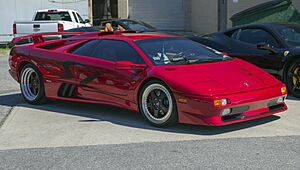
Lamborghini was working on a car to replace the Countach, called the Diablo. Marcello Gandini, who designed the Miura and Countach, created the original Diablo design. However, Chrysler's designers made changes to smooth out its sharp edges. The Diablo was planned for 1988, but it was delayed. Instead, a special 25th Anniversary Edition of the Countach was released.
In 1990, the Diablo was finally shown to the public. It was the fastest production car in the world at the time! Sales were so good that Lamborghini started making a profit. The company also began developing its V12 engines for powerboat racing. Profits increased, and Lamborghini enjoyed a good period.
However, this good time didn't last long. In 1992, sales dropped, and the Diablo became too expensive for many buyers. Lamborghini started losing money again, and Chrysler decided to sell the company.
Indonesian and Malaysian Ownership (1994–1997)
Chrysler sold Lamborghini to an Indonesian company called MegaTech in 1994. The new owners wanted Lamborghini to make more than just one or two models. They also wanted a car that more people could afford. In 1995, the Diablo was updated to the powerful SuperVeloce model.
Later in 1995, the company was restructured, with a Malaysian company also taking a share. In 1996, Vittorio di Capua became the new CEO. He cut costs and improved production. In 1997, Lamborghini finally made a profit, selling 209 cars. He also worked to use the Lamborghini name for merchandise and licensing. Development of a new, smaller Lamborghini car began with a large budget.
Audi Ownership (1998–Present)
New Era: Murciélago and Gallardo (1998–2007)
In 1998, the Volkswagen Group, led by Ferdinand Piëch, bought Lamborghini. Volkswagen's Audi division took control of Lamborghini. Audi believed Lamborghini could make its own brand sportier and benefit from Audi's technical knowledge.
Lamborghini was reorganized into a holding company. This allowed the car-making part of the company to focus only on designing and building cars. The Diablo's final version, the GT, was introduced in 1999. Over 11 years, Lamborghini produced 2,900 Diablos.
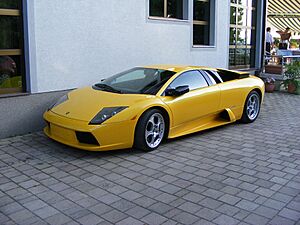
Audi's influence was big in designing the Diablo's replacement. The first new Lamborghini in over ten years was named the Murciélago. This name came from a famous bull that inspired Ferruccio Lamborghini years ago. The Murciélago was designed by Luc Donckerwolke, Lamborghini's new head of design.
The Murciélago was updated in 2005, becoming more powerful. It also introduced a new single-clutch transmission called E Gear, which used paddles to change gears. This transmission eventually replaced manual gearboxes.
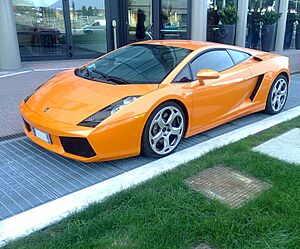
Under Audi, Lamborghini found stability. In 2003, Lamborghini launched the Gallardo. This smaller, V10-powered car was designed to be more accessible and easier to drive than the Murciélago. The Gallardo had many versions, including a convertible (Spyder), a rear-wheel-drive version (Balboni), and a lighter, track-focused version (Superleggera).
New Models and Challenges (2008–2010)
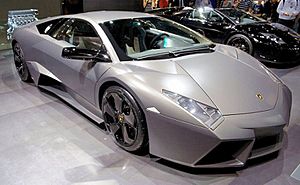
Towards the end of the 2000s, Lamborghini released special versions of the Murciélago and Gallardo. The Reventón was a limited-edition Murciélago with a sharp, new design. A convertible version followed. The final Murciélago update was the LP 670–4 SV in 2009.
Lamborghini produced the last Murciélago in May 2010, after making 4,099 cars over ten years.
The Gallardo was updated in 2008 with a more aggressive look and new lights. Its engine was also improved, making it more powerful. The updated Gallardo models also started using the E Gear transmission.
In 2008, Lamborghini had its best sales year ever, selling 2,430 cars. However, the world financial crisis that started in 2007 caused sales to drop significantly in 2009 and 2010.
Aventador, Huracán, and Urus (2011–Present)
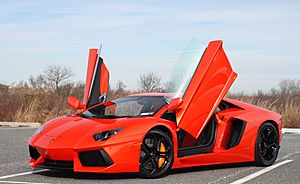
The Aventador, a powerful replacement for the Murciélago, was launched in 2011. It had a sharp, angular design and a completely new V12 engine. This marked the retirement of the original Lamborghini V12 engine designed by Giotto Bizzarrini. A convertible version of the Aventador was introduced in 2012.
In 2013, the Veneno was introduced. It was a very limited edition car with a radical design based on the Aventador. Only a few units were sold, making it one of the most expensive Lamborghinis ever.
For its 50th anniversary in 2013, Lamborghini released a special Aventador model. It had more power and unique styling.
In 2015, a lighter, more powerful, track-focused Aventador called the Aventador SV (SuperVeloce) was introduced. It had more aggressive styling and increased power.
The Centenario was launched in 2016 to celebrate Ferruccio Lamborghini's 100th birthday. It had an even more aggressive design and featured Lamborghini's new four-wheel steering system. Only 40 units were produced.
The Aventador was updated in 2017 and renamed the Aventador S. It had more power and also used the four-wheel steering system. The ultimate track-focused Aventador, the SVJ (SuperVeloce Jota), was introduced in 2018. It uses special active aerodynamics to improve its performance.
Towards the end of its production, special limited editions of the Gallardo were unveiled, like the Sesto Elemento in 2012. This car was very light and designed for track use.
Production of the Gallardo ended in November 2013. It was Lamborghini's best-selling model, with over 14,000 cars produced.
The Gallardo's replacement, the Huracán LP610-4, was announced in 2013 and debuted in 2014. The Huracán offered big improvements, including more power, faster acceleration, and a dual-clutch transmission. Different versions followed, including a convertible (Spyder) and a more powerful track version (Performante).
The Urus SUV was first shown as a concept in 2012 and then as a production model in 2017. It is Lamborghini's second off-road vehicle after the LM002. The Urus shares its platform with other Volkswagen Group SUVs but has unique Lamborghini technology and design.
In 2019, Lamborghini unveiled its first hybrid car, the Sián FKP 37. Its name means "flash of lightning" in Italian. It combines the Aventador's V12 engine with an electric motor powered by a special supercapacitor. This makes it the most powerful Lamborghini car.
In 2021, Lamborghini announced that the Aventador production would end. A new hybrid car will replace it. The last Aventador model is the 2022 Lamborghini Aventador Ultimae.
See also
- List of Lamborghini automobiles


